Why LinkedIn Matters
Seen as the “professional social network”, LinkedIn isn’t just a place to showcase your resume but is also a place where you can grow your reputation and your business. LinkedIn currently has a total of 260 million monthly active users, with the most recent surveys showing that 96 percent of lawyers maintaining a personal profile. It’s essential you optimize your profile as it will give you a nearly unparalleled opportunity to connect with both potential clients or referral sources.
It is by far the most popular social media tool among business people. 40% of these users check LinkedIn daily. Further, in a recent survey of professional service purchasers, 70% of those surveyed used LinkedIn to evaluate service providers. This suggests that whether or not people are finding you via LinkedIn (more about that in a minute) they are definitely checking you out using this venue.
You know you should have a LinkedIn account, but how do use it? We’ve put together this guide to help you maximize your profile on LinkedIn, which will help you build awareness of your practice and ultimately help you connect with new clients.
Setting Up a LinkedIn Account
Join
Go to www.linkedin.com and get started! Even if you already have an account, you should review this section and ensure you have set it up properly.
Fill out the required information, and click Join Now.
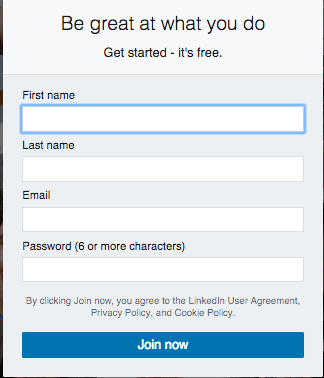
You might be requested to verify you're not a robot, either by verifying your phone number via verification code or choosing from a set of images.
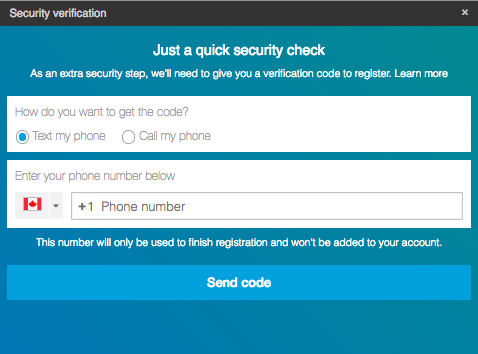
Start Your Profile
Fill out the relevant geographic and employment information.
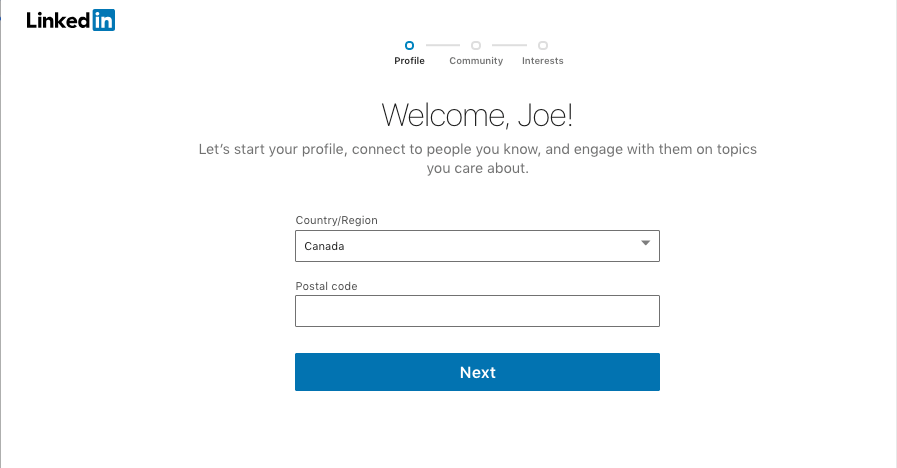
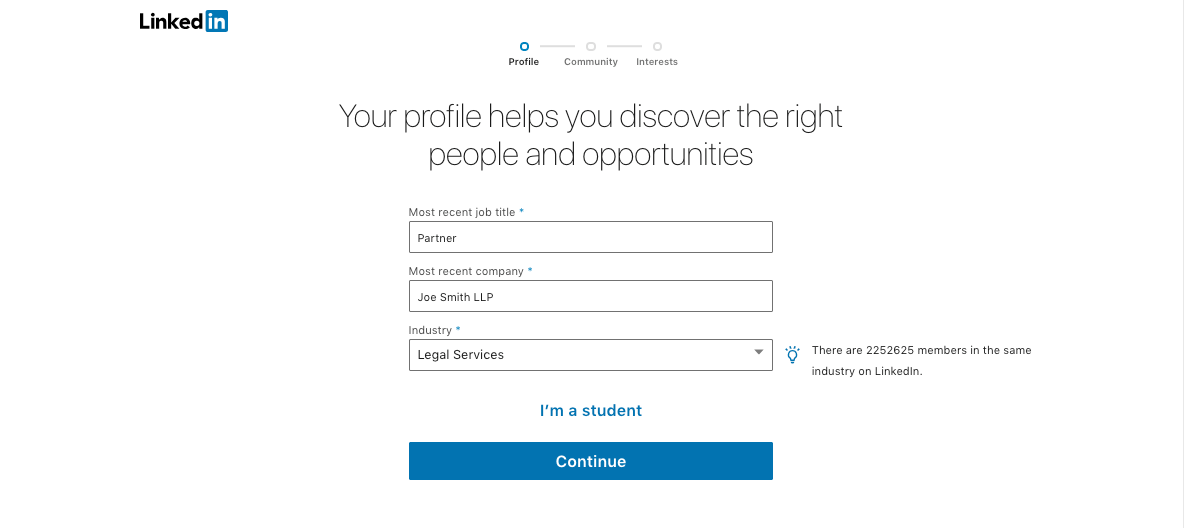
You will then be prompted to verify your e-mail address. A code will be sent to your email address, which you will then have to enter before clicking Agree & Confirm.

After verifying your e-mail, you will be given the option to import your contacts so you're able to see who you already know on LinkedIn. You can skip this step, or click Continue to start adding contacts.
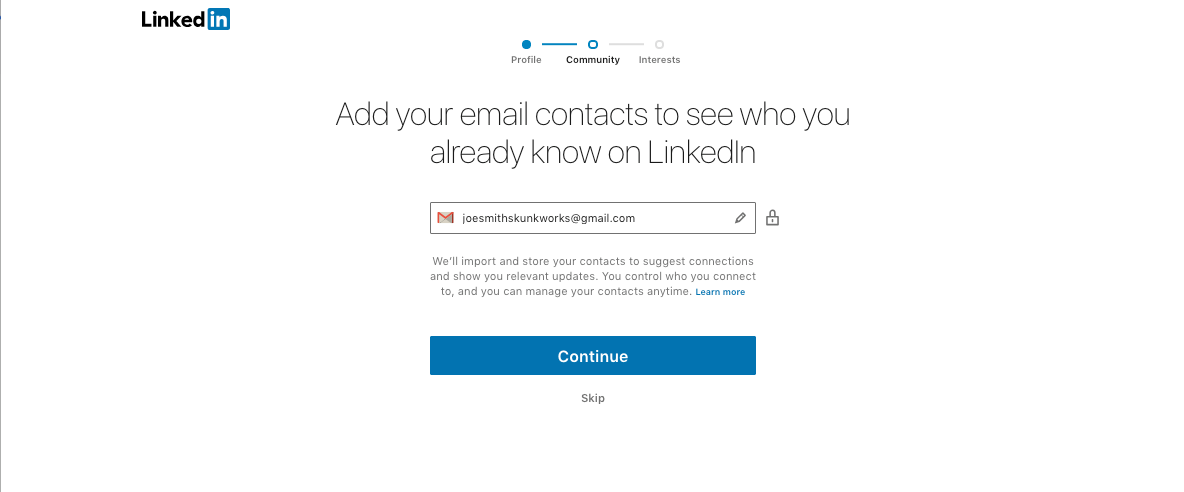
If you choose to add your email contacts to LinkedIn, you will be given the option to request to connect with these contacts either by clicking Connect [number of possible connections] or by unclicking the contacts you don't wish to connect with before clicking Connect [number of possible connections]. You can also skip this step by clicking Skip.

You'll then be given the option to connect with a number of people that the LinkedIn algorithm believes you may know (based on your e-mail address, place of work, etc). You're also able to Skip this step, add all the preselected connections, or unclick those who you don't wish to add.
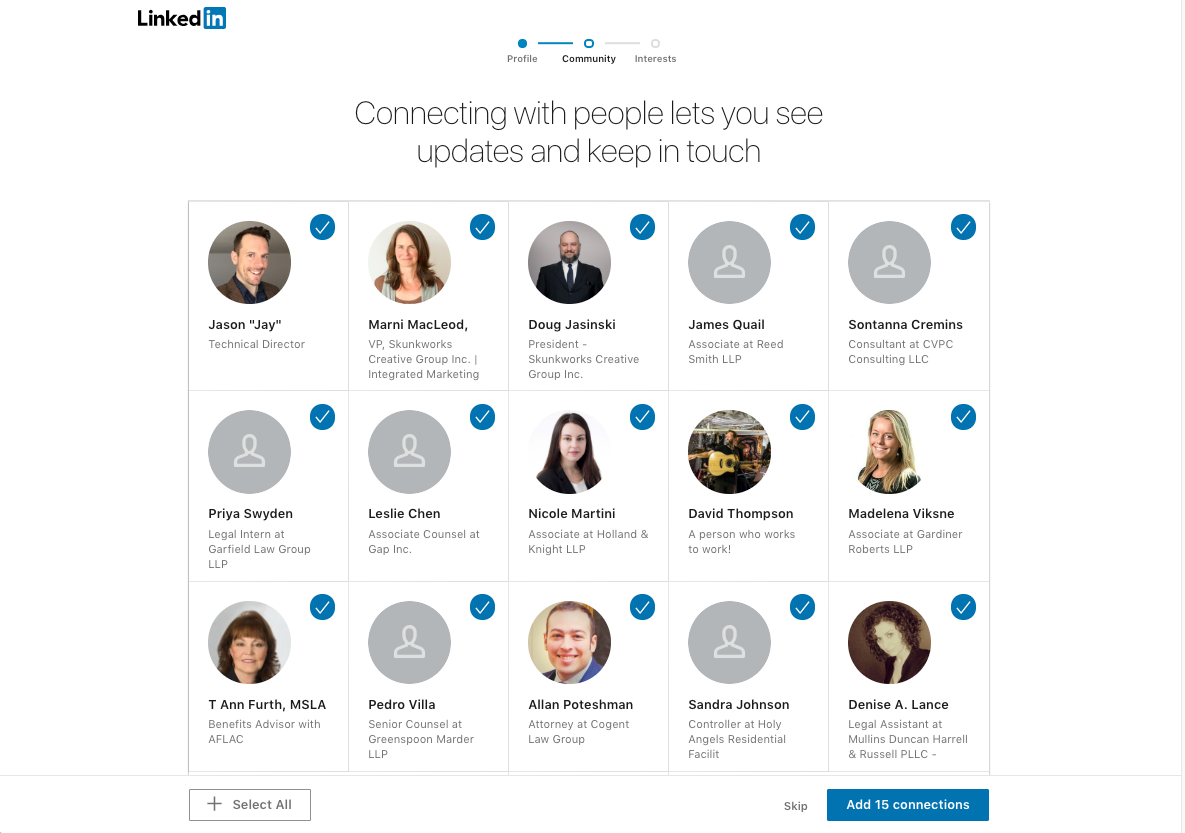
You'll now be given the opportunity to add a photo, by clicking Add photo.

Next, you'll be prompted to download the LinkedIn app, which you can do either by entering your phone number and clicking Text me the link or by downloading directly from the App Store or Google Play. You can also choose to Skip.

Optimize Your Account
Next, you'll be given the option to start optimizing your LinkedIn experience.
You'll first be asked to update your work start date, which you can do before clicking Save.

Then, you'll be given the option to build your network, which will give you the option to explore contacts LinkedIn believes you may want to connect with (based on your work history, email address, etc). The steps are the same as when you first set up your profile. Just click Find Connections to start.

You now will want to choose hashtags to follow. Once clicking Personalize your feed, you will be given the option to follow multiple hashtags relevant to your job title and industry. Just click Follow under the hashtags you want to follow.
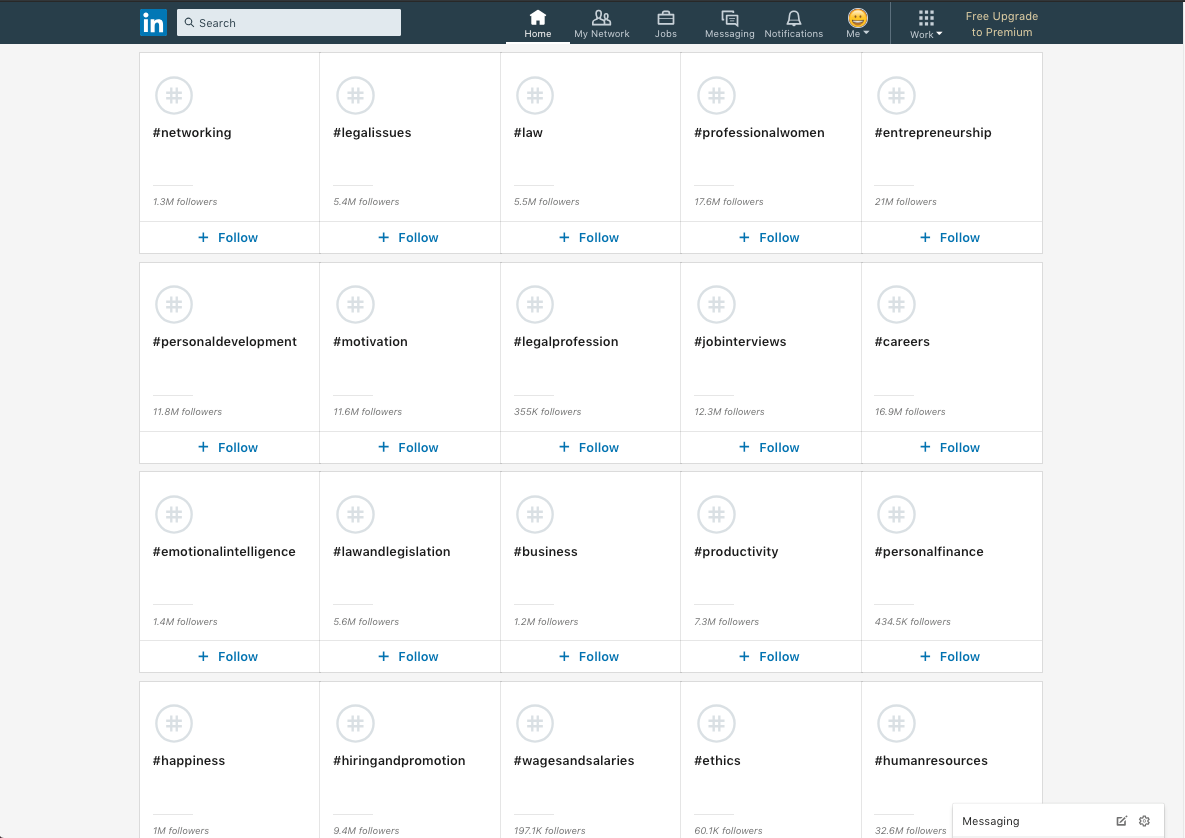
Set-up Your Profile
Now that you have started building your network and personalized your feed, you will want to work on your profile!
You can make changes by navigating to your profile by clicking Me in the upper right hand corner, then clicking View my profile.
Once you're in your profile, you can start editing and adding profile sections to your page. First, to add a profile section, click Add profile section.
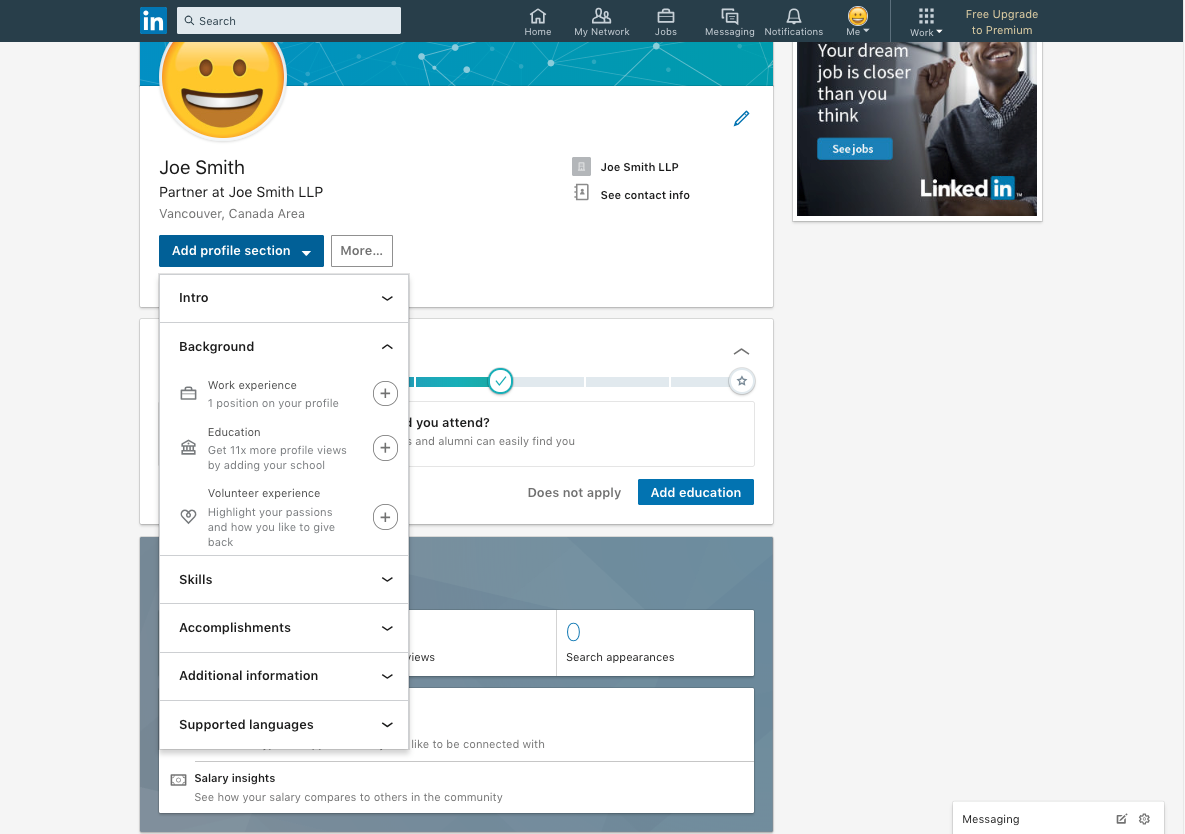
If you'd like to add a section to your profile, click the plus sign beside the section you wish to add. For example, you'd click the plus sign beside Work Experience if you'd like to add a job to your profile.
You could also include any relevant media to your work experience by clicking Upload under Media. Things like presentations or links to blog posts you've written might be appropriate here.

As you update your profile, LinkedIn will note your Profile Strength, which is based off how much information you have in your profile.
For example, they may prompt you to enter which university or school you've attended.

Or they may ask you to add 5 skills to showcase what you're great at. You can do this by manually typing in your skill (ie, Personal Injury Litigation) then clicking Enter, to add the skill.
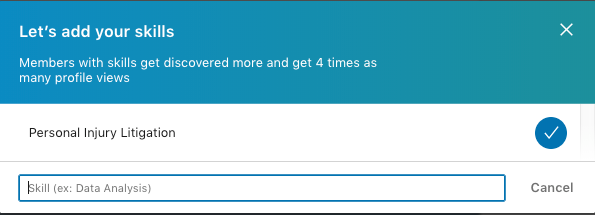
There are a number of other areas you can add to your profile, all by clicking the plus sign next to the section you wish to add.

Best Practices
Add a Profile Picture
LinkedIn is about relationship building and it’s easier to start that process if you have a visual impression of the person in your mind. This is particularly important for people who share the same name with others in their profession. Further, numerous studies have indicated that images often receive up to ten times the amount of user engagement as text on social media profiles.
Choose a profile picture that adequately represents your personal brand and the brand of your firm. The photo should be high resolution, in focus, and professionally shot whenever possible. If you do not include a picture in your profile or the photo you include is out-of-focus or unflattering, a user is far less likely to click on your profile when it appears in LinkedIn’s search results.
Add Your Full Name
We often see people using their first name and a last initial on LinkedIn. You should use the name that you would use when dealing with potential clients and referrals. If you have a formal title, use it.
If you'd like to change your name, you can do so by following the instructions here.
Confirm Your Contact Information is Up-to-Date
Click on the Edit Contact Info tab and review your contact information to make sure it is current.
Add a Summary
Your summary should provide a LinkedIn user with a quick glimpse of your expertise and abilities. The language that you use in this section of your profile should be short, to the point, and not overly idiomatic or dense with legal jargon. It is better to create a short summary than an extremely long one. LinkedIn best practices dictates that your summary be roughly 2-4 short paragraphs.
Tell people: Who you are, who you help and how.
Add a personal note about yourself so that people don’t feel like they are reading your resume…the goal is to connect with people on a personal level.
Include a call to action: tell people where they can get more information, what number to call or where to email you.
Confirm you have a Custom Public URL
When LinkedIn allocates a profile the website address (URL) will look like a bunch of numbers and letters. In short, people won’t know it’s you. A custom URL allows you to identify your profile with your name. This, in turn will allow you to use your LinkedIn profile in your other marketing pieces (like your website bio, your business card, presentations you give and so on).
An example of a custom URL is: ca.linkedin.com/in/yourname
To set up a custom URL, navigate to your profile and click Edit Public Profile & URL in the upper right hand corner

This will show you what your public facing profile looks to those visiting it. If you'd like to personalize your URL, navigate to Edit URL in the right hand corner and click the pencil next to the URL.
Review Your Privacy Settings
One thing you should definitely do is review your Privacy & Settings details to make sure they are set up the way you want. You find that page by clicking Me in the upper right hand corner, then clicking Settings & Privacy.

Add a Detailed Account of Your Work Experience
You can start by evaluating your profile as compared with others in your practice area.
You do not have to include every job that you have ever had. However, you should adequately detail the work experience that you do include. Legal professionals tend to forget that their clients are not always well versed in the legal industry. If you simply include a firm name in the “Work Experience” section of your profile, than it is unlikely that a client will fully appreciate your expertise or fully understand how you can be of service.
Try to incorporate descriptive key words (key words are words and phrases that people would use if they were searching for your services on Google)
Add Projects if Appropriate
Assuming client confidentiality does not pose any issues, you can use the Projects section of LinkedIn to detail specific projects that showcase your expertise. You can also add team members to Projects, which is useful if your firm advocates a team approach to providing legal services. You can arrange these projects in whatever order you like. For example, if you have worked on a high profile deal or case you may wish to position it at the top of your list of Projects.
Further, the Projects feature allows you to provide links back to other online platforms. If you have a detailed description of the case or project in question on your firm website, than you can provide a link back to that page.
If you're not sure how to add projects to your profile, follow these instructions here.
Add Skills & Expertise
You can select from among a variety of skills and areas of expertise to add to your profile, which other linked in members can endorse. This is an easy way for former clients and other LinkedIn users to broadcast your expertise. Also, listing your skills lets current connections, who may have hired you on a particular matter or know you for a particular area of expertise, know that your expertise extends into other areas where they (or their contacts) may need services. Your current connections are also your referral network so it’s important that they have an awareness of the full range of your abilities.
You can add skills to your profile by following the instructions here.
Have Your Skills or Expertise Endorsed
LinkedIn allows individuals with LinkedIn accounts to endorse one another’s skills. Think of a LinkedIn endorsement as a "like" for your skills. It is important to note that you cannot endorse yourself for a skill. You can only be endorsed by another LinkedIn user.
If you'd like some more information on how have someone endorse your skills, or have them endorse you, please see this LinkedIn Help Centre article.
Receive Recommendations
Recommendations are similar to endorsements in the sense that they can only be added to your profile by other LinkedIn users. Recommendations are more significant than endorsements as they give users the opportunity to specifically outline your standard of professionalism and the work that you accomplished for them.
If you'd like more information on how to accept and display recommendations, please see this LinkedIn Help Centre article.
LinkedIn Status Updates
If you are not on the Home page, click the Home icon in the black bar along the top of the page, and look for the Share an article, photo, video or idea field.
When there, you can click and start typing or use @ to mention someone.

You can post about something new and upcoming at your firm, industry trends, a brief piece of advice, a link to an article in which you were quoted, or recent results to key work. Include questions in your post for more engagement.
Note: Limiting the length of your message is shown to increase engagement. Status updates have a 600-character maximum. If you are drafting your post in Word you can check the length of a post using the Word count feature under the “Tools” menu.
Include a call to action. For example, a URL to a blog post, a YouTube video, or a desired landing page. Use bit.ly or Google URL shortener to shorten URL links.
LinkedIn Groups
LinkedIn Groups are essentially hubs that focus around one general topic of conversation which provide "a place for professionals in the same industry or with similar interests to share content, find answers, post and review jobs, make business contacts, and establish themselves as industry experts".
You can start your own group or participate in any group that is relevant to your practice area or interests.
